Exploring the Timeline of Car Taillight’s History and Facts
- Early Era
- Brake Light Invention
- Advent of Turn Signals
- Halogen and LED Lights
- Future of Taillights
- FAQs
Automotive lighting has come a long way in terms of innovation. Today, cars come equipped with different types of lights, among which headlights and taillights are the most eminent ones. Similar to headlights, taillights play a crucial role in vehicle safety and overall aesthetics. Taillights, also known as rear lights, have undergone significant transformation since they were invented. Their appearance and functionality impact a car’s overall presence imperatively. For those who are curious to know how the story of rear lights started, here’s a timeline of important development. Let’s learn about the history of car taillights and their technological advancements over the years.
History of Car Taillights
Similar to the evolution of car headlights, taillight innovations over the years have an interesting timeline of facts and developments. We’ll now start detailing it from the early times.
Car Taillight Design History: Early Days
During the brass car era, vehicles relied on oil lamps for illumination. Though these lamps provided minimal lighting, they at least signalled a vehicle’s presence on the road. As automotive technology progressed, the introduction of dynamos in the late 1920s enabled vehicles to generate small amounts of electrical power. This advancement led to the adoption of headlights and tail lights, which resulted in improved nighttime visibility and road safety.
The Advent of Brake Lights

One of the earliest concepts for a brake light came from Florence Lawrence, a pioneering film star and inventor. She designed a bumper-mounted sign that displayed the word ‘STOP’ when the driver pressed the brake pedal. This new system offered a clear warning to other motorists. However, she never patented her idea, which allowed automakers to develop it further. All in all, this innovation laid the foundation for modern brake lights. During the same era, the auto-signalling arm was also introduced, which served as a precursor to today’s turn signals.
The Standardisation of Brake Lights
As automobile usage increased, so did the need for standardised safety features. By the 1920s, several automotive laws and regulations were introduced in different countries for taillights. Most of the legal requirements outlined for vehicles to have a red tail light at the rear with a brake warning. As a result, brake lights became a mandatory and widely available feature in most countries.
The Introduction of Turn Signals in the Evolution of Car Taillights
In the 1930s and 1940s, automakers began incorporating turn signals into vehicle lighting systems. While early turn signals were mechanical arms that extended from the vehicle, electrical indicators quickly replaced them. Given their uniqueness, mechanical arm turn signals are the classic car features we miss today and will never forget. By the 1950s, integrated tail lights with turn signals became commonplace. Cars with turn signals reduced the risk of accidents caused by miscommunication between drivers otherwise.
Development of Tail Light Technology: The Halogen Era
In the 1960s and 1970s, halogen bulbs started replacing traditional incandescent bulbs in tail lights. Halogen lights were more efficient, lasted longer and provided better illumination. This period also saw the rise of taillight designs that complemented the functionality and aesthetics of cars.
LED Revolution: Efficiency and Customisation

The 1990s and 2000s marked the shift toward Light Emitting Diode (LED) technology. LEDs revolutionised tail light design by offering brighter illumination, faster response times, lower energy consumption and longer lifespan. Their small size also allowed for more customisation and distinctive taillight designs. The invention and availability of different types of taillights greatly benefited the automotive sector in myriad ways, especially in terms of styling, safety and efficiency.
The Future: Smart and Adaptive Tail Lights
Today, automotive lighting technology continues to advance with the integration of smart features. For instance, some cars now feature adaptive taillights, which adjust brightness based on ambient conditions. Similarly, there is OLED (Organic Light Emitting Diode) technology, which offers even more design flexibility and energy efficiency. Some high-end vehicles also feature dynamic lighting systems that communicate braking intensity to alert drivers behind. The technology aids motorists in maintaining a safe following distance, reducing accident risks
FAQs
When were car taillights first introduced?
Car taillights were first introduced in the late 1910s with the advent of electric lighting systems in vehicles.
What were the first cars to use electric taillights?
The first cars to use electric taillights were the 1915 Cadillac models, which featured an integrated electric lighting system.
How have modern taillights improved safety?
Modern taillights, especially adaptive taillights, improve safety by adjusting brightness based on ambient conditions and braking intensity. This system not only enhances visibility but also reduces the risks of rear-end collisions. It timely warned the drivers behind about the vehicle’s braking intensity.
From oil lamps to sophisticated adaptive taillights, the history of automotive lighting is marked by constant innovation. The historical milestones of taillight design have made significant strides. The advancements continue to push the boundaries of the taillight concept and functionality. Moreover, when choosing a tail light for your car, keep all such know-how in mind to make an informed choice.
Many new and used cars for sale in the UAE have modern-day taillights. The higher-end ones have rear and brake lights with sophisticated features, enhancing safety and overall car profile.
For more updates on modern vehicle features and their evolution, keep following UAE’s top car blog.
Comments
Post a Comment